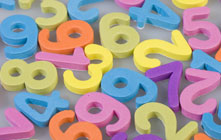5th Grade Multiplication: Concepts and Sample Problems
Kids usually begin learning multiplication in 3rd grade. In 4th grade, they learn to multiply up to 4-digit numbers by 1-digit multipliers and 2-digit numbers by 2-digit multipliers. Most multiplication concepts have been introduced by 5th grade when multiplication of fractions is covered.

Multiplication Concepts Learned in 5th Grade
Kids in 5th grade continue to use drawings and concrete models to demonstrate how to solve problems. Integrating the multiplication properties and place-value strategies, they explain the reasoning for the math steps they use. Additionally, they not only solve story problems but also make their own story problems based on equations they're given.
Multiplying 3-Digit Numbers
Fifth graders learn that multiplying 3-digit numbers is just like multiplying 2-digit numbers, except you perform the steps an additional time. This is true no matter how many digits the factors have. Problems such as 13579 x 2468 should cause no headaches as long as the students remember three basics: addition facts, multiplication tables and keeping their work in proper columns.
Multiplying Decimals
Using the standard algorithm for long multiplication, 5th graders learn to multiply decimals to the hundredths. Based on what they know about multiplying two numbers with three or more digits, they'll be able to carry that knowledge to multiplying numbers with decimal points, such as 12.34 x 56.78.
In 5th grade, the emphasis is on how to determine where the decimal point belongs in the product. Students must count the total number of digits following the decimals in both factors and then place the decimal point in the product after the same number of digits from the right side of the product. For example, for a problem like 12.34 x 56.7 = 699.678, students learn that the decimal point will be three digits (two from 12.34 plus one from 56.7) from the right in the product: 699678 becomes 699.678.
Multiplying Fractions
Knowledge of multiplication is extended to multiplying a whole number or a fraction by a fraction, such as:
- 3 x 1/2 = 3/2 = 1 1/2
- 1/4 x 1/2 = 1/8
Students learn to multiply two fractions by multiplying the numerators of the two fractions for the new numerator and multiplying the two denominators for the new denominator. Explain the logic behind the common presentation of this rule:
- a/b x c/d = ac/bd
- 4/5 x 2/3 = (4 x 2) ÷ (5 x 3) = 8/15
Also emphasize two observable facts or properties when multiplying with fractions:
- If you multiply a number by a fraction that's larger than 1, the product is bigger than the number multiplied. Example: 5 x 3/2 = 15/2 = 7 1/2; 7 1/2 is larger than 5.
- If you multiply a number by a fraction that's smaller than 1, the product is smaller than the number multiplied. Example: 5 x 1/2 = 5/2 = 2 1/2; 2 1/2 is smaller than 5.
Sample Multiplication Problems
1. 368 x 312
- When you multiply a number by a 3-digit number, multiply by the ones' place first (in this problem that's '2,' so multiply 368 x 2 and you get 736). Put a 0 below the 6, then multiply by the tens' place (368 x 1 = 368). Write this number in front of the 0 (3680). Put two zeros below the 80 in 3680. Next, multiply the hundreds' place (368 x 3 = 1104). Write this in front of the two zeros (110400). Add these three answers together (736 + 3680 + 110400) and you have the answer to the problem: 114,816.
2. 8.62 x 7.4
- Multiply 8.62 x 7.4 as you would a multiplication problem without decimals (as described in the first sample problem). Then count how many digits come after each decimal point and add them together (two digits in 8.62 and one digit in 7.4; so there should be three digits after the decimal point). Look at the answer - 63788 - and count three digits from the right and place the decimal point in front of the third digit, giving you 63.788.
3. Create a story for this problem: $3.62 x 12.5 = $45.25
- My dad bought 12.5 gallons of gas for $3.62 a gallon. How much did he spend?
4. 4/5 x 2/3
- When you multiply two fractions, multiply the two numerators (4 x 2 in this problem), and then the two denominators (5 x 3). This gives you an answer of 8/15.
5. 6 x 1/4
- When you multiply a whole number by a fraction, first convert the whole number into a fraction like this: 6 = 6/1. Then solve it by multiplying the two numerators (6 x 1) and then the two denominators (1 x 4) to get 6/4. Next, reduce fraction to the lowest denominator to get 3/2, which may also be written as a mixed number, 1 1/2.
Other Articles You May Be Interested In
-
Sample Math Worksheet - Simple and Advanced Multiplication Tables

This sample worksheet shows you how to structure both basic and advanced multiplication tables. These formats are meant to help students memorize simple multiplcation problems and, when randomized, challenge them.
-
Tips to Helping your Fourth Grader with Multiplication Homework

Here are some ways to help your child learn multiplication and make fourth grade math homework fun.
We Found 7 Tutors You Might Be Interested In
Huntington Learning

- What Huntington Learning offers:
- Online and in-center tutoring
- One on one tutoring
- Every Huntington tutor is certified and trained extensively on the most effective teaching methods
K12

- What K12 offers:
- Online tutoring
- Has a strong and effective partnership with public and private schools
- AdvancED-accredited corporation meeting the highest standards of educational management
Kaplan Kids

- What Kaplan Kids offers:
- Online tutoring
- Customized learning plans
- Real-Time Progress Reports track your child's progress
Kumon

- What Kumon offers:
- In-center tutoring
- Individualized programs for your child
- Helps your child develop the skills and study habits needed to improve their academic performance
Sylvan Learning

- What Sylvan Learning offers:
- Online and in-center tutoring
- Sylvan tutors are certified teachers who provide personalized instruction
- Regular assessment and progress reports
Tutor Doctor

- What Tutor Doctor offers:
- In-Home tutoring
- One on one attention by the tutor
- Develops personlized programs by working with your child's existing homework
TutorVista

- What TutorVista offers:
- Online tutoring
- Student works one-on-one with a professional tutor
- Using the virtual whiteboard workspace to share problems, solutions and explanations